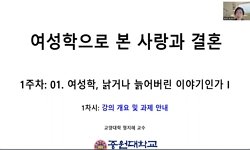The purpose of this study is to analyze the effect of the flexible working arrangement from the perspective of gender equality. To this end, we analyze the context in which the flexible working system is introduced and used in Korean companies, and ex...
http://chineseinput.net/에서 pinyin(병음)방식으로 중국어를 변환할 수 있습니다.
변환된 중국어를 복사하여 사용하시면 됩니다.
- 中文 을 입력하시려면 zhongwen을 입력하시고 space를누르시면됩니다.
- 北京 을 입력하시려면 beijing을 입력하시고 space를 누르시면 됩니다.

젠더 관점에서 본 유연근무제의 필요성과 딜레마 = The Necessity and Dilemma of Flexible Working Arrangements from the Gender Perspective
한글로보기https://www.riss.kr/link?id=A107986973
- 저자
- 발행기관
- 학술지명
- 권호사항
-
발행연도
2021
-
작성언어
Korean
-
주제어
유연근무제도 ; 여성 ; 돌봄 ; 가족친화제도 ; 성평등 ; flexible working arrangement ; gender ; care ; family-friendly system ; gender equality
-
등재정보
KCI등재
-
자료형태
학술저널
- 발행기관 URL
-
수록면
1-39(39쪽)
-
KCI 피인용횟수
0
- 제공처
-
0
상세조회 -
0
다운로드
부가정보
다국어 초록 (Multilingual Abstract)
As a result of the study, Korean companies have introduced flexible working systems for the purposes of securing female workers, improving work efficiency according to the implementation of the 52-hour work week, and supporting work-life balance. By accommodating the demands of workers with family responsibilities, such as working mothers, women's career interruptions are prevented and employees' autonomy of working time and place are improved.
These resulted in workers’ high satisfaction and work concentration.
Nevertheless, workers who still need time flexibility in a performance-oriented corporate culture are likely to be undervalued. In addition, the flexible working arrangement is not welcomed under the rule of the male breadwinner rule, which places importance on the effect of a wage increase based on long hours of work. However, flexible working is spreading in Korea as well during the COVID-19 period. In order for this system to be effective as a means to protect women's employment and reduce the gender gap, a change in the way companies evaluate performance by 'absolute time input', is necessary.
The purpose of this study is to analyze the effect of the flexible working arrangement from the perspective of gender equality. To this end, we analyze the context in which the flexible working system is introduced and used in Korean companies, and examine the consequences it has on female and male workers. As research participants, 30 companies were selected from among the companies that were certified as family-friendly companies by Ministry of Gender Equality, and we conducted interviews with HR managers at those companies.
As a result of the study, Korean companies have introduced flexible working systems for the purposes of securing female workers, improving work efficiency according to the implementation of the 52-hour work week, and supporting work-life balance. By accommodating the demands of workers with family responsibilities, such as working mothers, women's career interruptions are prevented and employees' autonomy of working time and place are improved.
These resulted in workers’ high satisfaction and work concentration.
Nevertheless, workers who still need time flexibility in a performance-oriented corporate culture are likely to be undervalued. In addition, the flexible working arrangement is not welcomed under the rule of the male breadwinner rule, which places importance on the effect of a wage increase based on long hours of work. However, flexible working is spreading in Korea as well during the COVID-19 period. In order for this system to be effective as a means to protect women's employment and reduce the gender gap, a change in the way companies evaluate performance by 'absolute time input', is necessary.
국문 초록 (Abstract)
이 연구는 성평등 관점에서 유연근무제도의 효과를 분석하는 데 목적이 있다. 이를 위해한국 기업에서 유연근무제도가 도입되는 맥락과 활용되는 상황을 분석하고, 이것이 여성과남성 노동...
이 연구는 성평등 관점에서 유연근무제도의 효과를 분석하는 데 목적이 있다. 이를 위해한국 기업에서 유연근무제도가 도입되는 맥락과 활용되는 상황을 분석하고, 이것이 여성과남성 노동자에게 가져오는 결과를 살펴보았다. 연구대상으로 유연근무제도 활용 정도가 높거나 관련 컨설팅 경험이 있는 기업 30곳을 선정하여 인사담당자에 대한 면접조사를 실시하였다. 연구 결과, 기업들은 외국계 기업의 자회사로서 본사의 방침을 수용하거나, 여성인력 확보, 주 52시간 노동제 시행에 따른 업무 효율화 전략, 일ㆍ생활 균형 지원 정책의 목적으로유연근무제도를 도입해 왔다. 시차출퇴근제, 선택시간근로제, 재택근무 등이 주로 이용되며, 가족의 돌봄 책임을 가진 노동자들의 요구를 수용함으로써 여성의 경력단절을 예방하고 높은만족도와 업무 집중도를 가져오는 것으로 나타났다. 그럼에도 불구하고 여전히 성과지향적인기업 문화 속에서 시간 유연성을 필요로 하는 노동자는 낮은 평가를 받기 쉽다. 또 장시간 노동에 기초한 임금 인상 효과를 중요시하는 남성생계부양자 규범에 따라 유연근무제도가 환영받지 못하거나 이를 이용하는 여성들의 경우 더 큰 성과를 보여주어야 한다는 압박을 느낄 수있다. 그러나 코로나19 시기를 거치면서 유연근무제가 한국에서도 점차 확산되고 있다. 이 제도가 여성의 고용 단절을 막고 성별 격차를 줄이기 위한 효과적인 수단이 되기 위해서는 남녀모두의 보편적 이용 이외에 ‘절대적 시간 투입량’에 의해 결정되는 기업의 성과평가 방식의변화가 필요하다는 결론을 도출하였다.
참고문헌 (Reference)
1 정재우, "한국의 유연근무제 도입현황" 146 : 87-92, 2017
2 통계청, "지역별고용조사"
3 국미애, "주 52시간 근무 상한제, 노동시간 단축과 젠더" 39 (39): 71-99, 2018
4 홍승아, "일・가정양립의 관점에서 본 유연근무제: 전략적 선택인가, 젠더 함정인가?" 한국가족학회 24 (24): 135-165, 2012
5 정희정, "일·생활 균형 및 성평등 현안과 유연근로제의 한계" 2019 (2019): 49-60, 2019
6 전형진, "유연근무제의 도입 현황과 향후 과제" 2020
7 고용노동부 일생활균형, "유연근무제"
8 류성민, "유연근로제도 실태조사 결과 및 정책적 시사점" 168 : 9-24, 2019
9 이은아, "여성 고용 확대를 위한 근로시간 유연화 제도 실태 및 활성화 방안 연구" 여성가족부 2020
10 이은아, "여성 고용 안정화를 위한 유연근무제도 활성화 방안 연구" 한국여성학회 37 (37): 39-73, 2021
1 정재우, "한국의 유연근무제 도입현황" 146 : 87-92, 2017
2 통계청, "지역별고용조사"
3 국미애, "주 52시간 근무 상한제, 노동시간 단축과 젠더" 39 (39): 71-99, 2018
4 홍승아, "일・가정양립의 관점에서 본 유연근무제: 전략적 선택인가, 젠더 함정인가?" 한국가족학회 24 (24): 135-165, 2012
5 정희정, "일·생활 균형 및 성평등 현안과 유연근로제의 한계" 2019 (2019): 49-60, 2019
6 전형진, "유연근무제의 도입 현황과 향후 과제" 2020
7 고용노동부 일생활균형, "유연근무제"
8 류성민, "유연근로제도 실태조사 결과 및 정책적 시사점" 168 : 9-24, 2019
9 이은아, "여성 고용 확대를 위한 근로시간 유연화 제도 실태 및 활성화 방안 연구" 여성가족부 2020
10 이은아, "여성 고용 안정화를 위한 유연근무제도 활성화 방안 연구" 한국여성학회 37 (37): 39-73, 2021
11 신경아, "시간제 노동과 성평등: 박근혜 정부의 시간제 일자리 창출 정책에 대한 비판적 논의" 한국여성학회 30 (30): 81-112, 2014
12 신경아, "시간선택제 여성노동자의 조직 내 주변화에 관한 연구" 한국여성학회 31 (31): 131-179, 2015
13 신경아, "비정규직 여성노동자의 교차적 차별 경험에 관한 연구" 한국여성학회 33 (33): 77-118, 2017
14 권혜원, "비교연구의 관점에서 본 한국의 유연근무제와 일-생활 균형: 제도의 실효성을 저해하는 요인은 무엇인가?" 한국전문경영인학회 19 (19): 71-99, 2016
15 신경아, "노동의 불안정성과 젠더─ 시론적 접근" 한국여성연구소 19 (19): 173-206, 2019
16 고용노동부, "근로기준법상 근로시간 규정의 주요내용"
17 한국CXO연구소, "국내 주요 30개 대기업의 1999년 대비 2019년 남녀 성비 및평균 보수 변동 현황"
18 Chung, H, "’Women’s Work Penalty’ in Access to Flexible Working Arrangements across Europe" 25 (25): 23-40, 2019
19 Lott, Y, "Working-time Flexibility and Autonomy : A European Perspective on Time Adequacy" 21 (21): 259-274, 2015
20 Brewer, A. M, "Work Design for Flexible Work Scheduling : Barriers and Gender Implications" 7 (7): 33-44, 2000
21 Chung, H., "Women’s Employment Patterns after Childbirth and the Perceived Access to and Use of Flexitime and Teleworking" 71 (71): 47-72, 2018
22 Himmelweit, S, "The Right to Request Flexible Working: A ‘Very British’Approach to Gender (In)Equality?" 33 (33): 246-263, 2007
23 Xiang, N., "The Benefits and Penalties of Formal and Informal Flexible Working-Time Arrangements: Evidence from a Cohort Study of Australian Mothers" 2021
24 Eurofound, "Sixth European Working Conditions" 2015
25 Chung, H, "Gender, Flexibility Stigma and the Perceived Negative Consequences of Flexible Working in the UK" 151 : 521-545, 2020
26 Lott, Y., "Gender Discrepancies In The Outcomes of Schedule Control on Overtime Hours and Income in Germany" 32 (32): 52-765, 2016
27 Ierodiakonou, C., "Flexitime and Employee Turnover : The Polycontextuality Job Regulation as Cross-National Institutional Contingency" 28 (28): 3003-3026, 2017
28 Leichty, J. M., "Flexible Workplace Policies : Lessons From the Federal Alternative Work Schedules Act" 56 : 304-317, 2007
29 Chung, H., "Flexible Working, Work-Life Balance, and Gender Equality : Introduction" 151 : 365-381, 2020
30 Chung, H, "Dualization and The Access to Occupational Family-Friendly Working-Time Arrangements Across Europe" 52 (52): 491-507, 2018
31 Lott, Y, "Does Flexibility Help Employees Switch Off from Work? Flexible Working-Time Arrangements and Cognitive Work-to-Home Spillover for Women and Men in Germany" 151 : 471-494, 2020
32 European Parliament and of the Council, "Directive (EU) 2019/1158 of the European Parliament and of the Council of 20 June 2019 on Work-Life Balance for Parents and Carers and Repealing Council Directive 2010/18/EU"
33 Williams, J. C., "Cultural Schemas, Social Class, and the Flexibility Stigma" 69 (69): 209-234, 2013
34 Chung, H., "Covid-19, Flexible Working, and Implications for Gender Equality in the United Kingdom" 35 (35): 218-232, 2021
35 Swanberg, J. E., "A Question of Justice : Disparities in Employees’ Access to Flexible Schedule Arrangements" 26 (26): 866-895, 2005
36 고용노동부, "2019년 기준 일가정양립실태조사" 2020
37 과학기술정보통신부, "2019 ICT 실태조사" 2019
동일학술지(권/호) 다른 논문
-
- 한국가족학회
- 문지선
- 2021
- KCI등재
-
TV가 재현하는 이혼한 한부모 여성의 모성 실천과 함의 : <용감한 솔로육아-내가 키운다>를 중심으로
- 한국가족학회
- 김미라
- 2021
- KCI등재
-
대학생이 지각한 부모의 심리적 통제가 사회불안에 미치는 영향 : 내현적 자기애와 자기효능감의 순차적 매개효과
- 한국가족학회
- 왕소희
- 2021
- KCI등재
-
- 한국가족학회
- 이은지
- 2021
- KCI등재
분석정보
인용정보 인용지수 설명보기
학술지 이력
| 연월일 | 이력구분 | 이력상세 | 등재구분 |
|---|---|---|---|
| 2027 | 평가예정 | 재인증평가 신청대상 (재인증) | |
| 2021-01-01 | 평가 | 등재학술지 유지 (재인증) |  |
| 2018-01-01 | 평가 | 등재학술지 유지 (등재유지) |  |
| 2015-01-01 | 평가 | 등재학술지 유지 (등재유지) |  |
| 2011-01-01 | 평가 | 등재학술지 유지 (등재유지) |  |
| 2009-01-01 | 평가 | 등재학술지 유지 (등재유지) |  |
| 2007-01-01 | 평가 | 등재학술지 유지 (등재유지) |  |
| 2004-01-01 | 평가 | 등재학술지 선정 (등재후보2차) |  |
| 2002-01-01 | 평가 | 등재후보학술지 선정 (신규평가) |  |
학술지 인용정보
| 기준연도 | WOS-KCI 통합IF(2년) | KCIF(2년) | KCIF(3년) |
|---|---|---|---|
| 2016 | 1.21 | 1.21 | 1.32 |
| KCIF(4년) | KCIF(5년) | 중심성지수(3년) | 즉시성지수 |
| 1.4 | 1.41 | 1.785 | 0.11 |





 KCI
KCI 스콜라
스콜라






